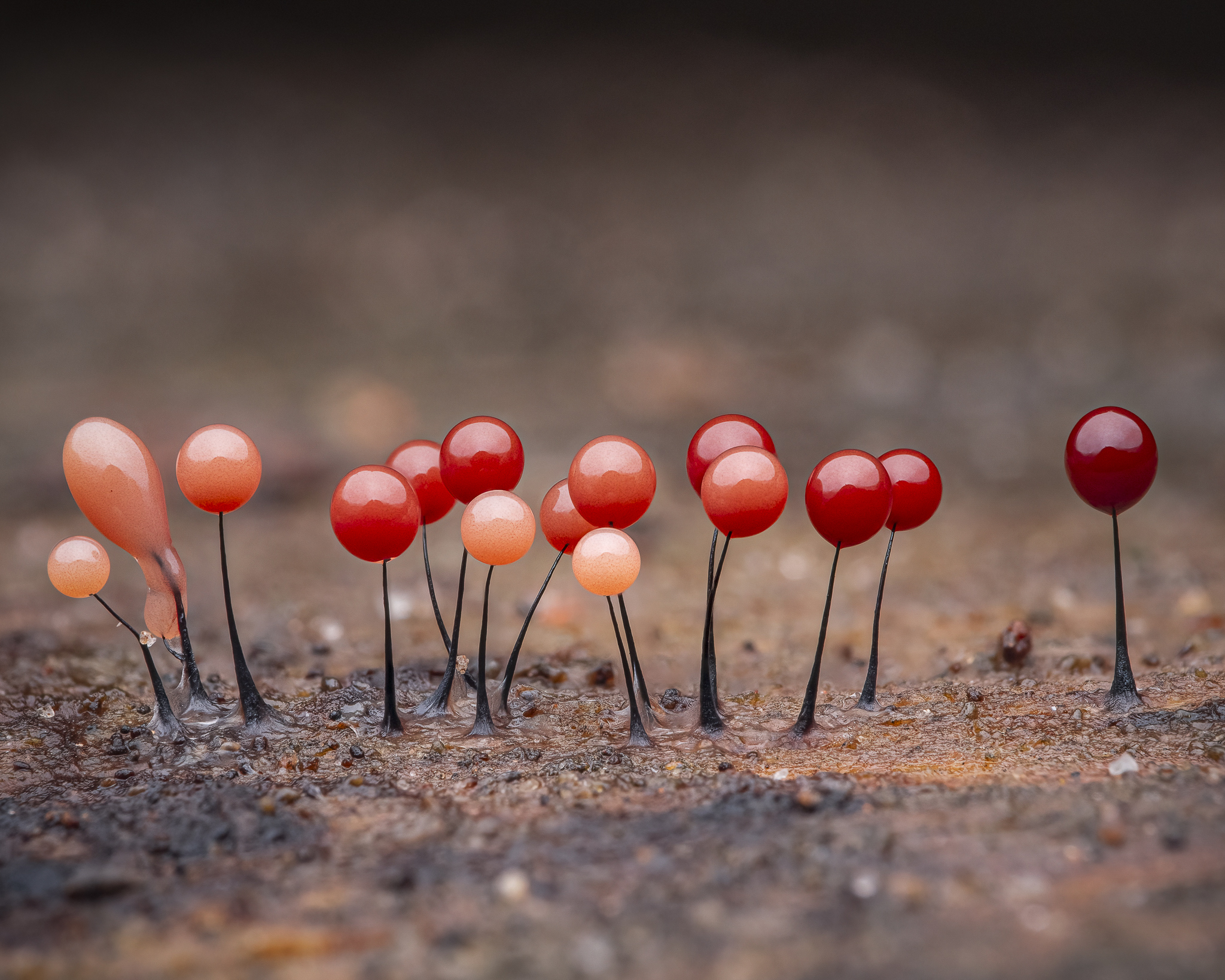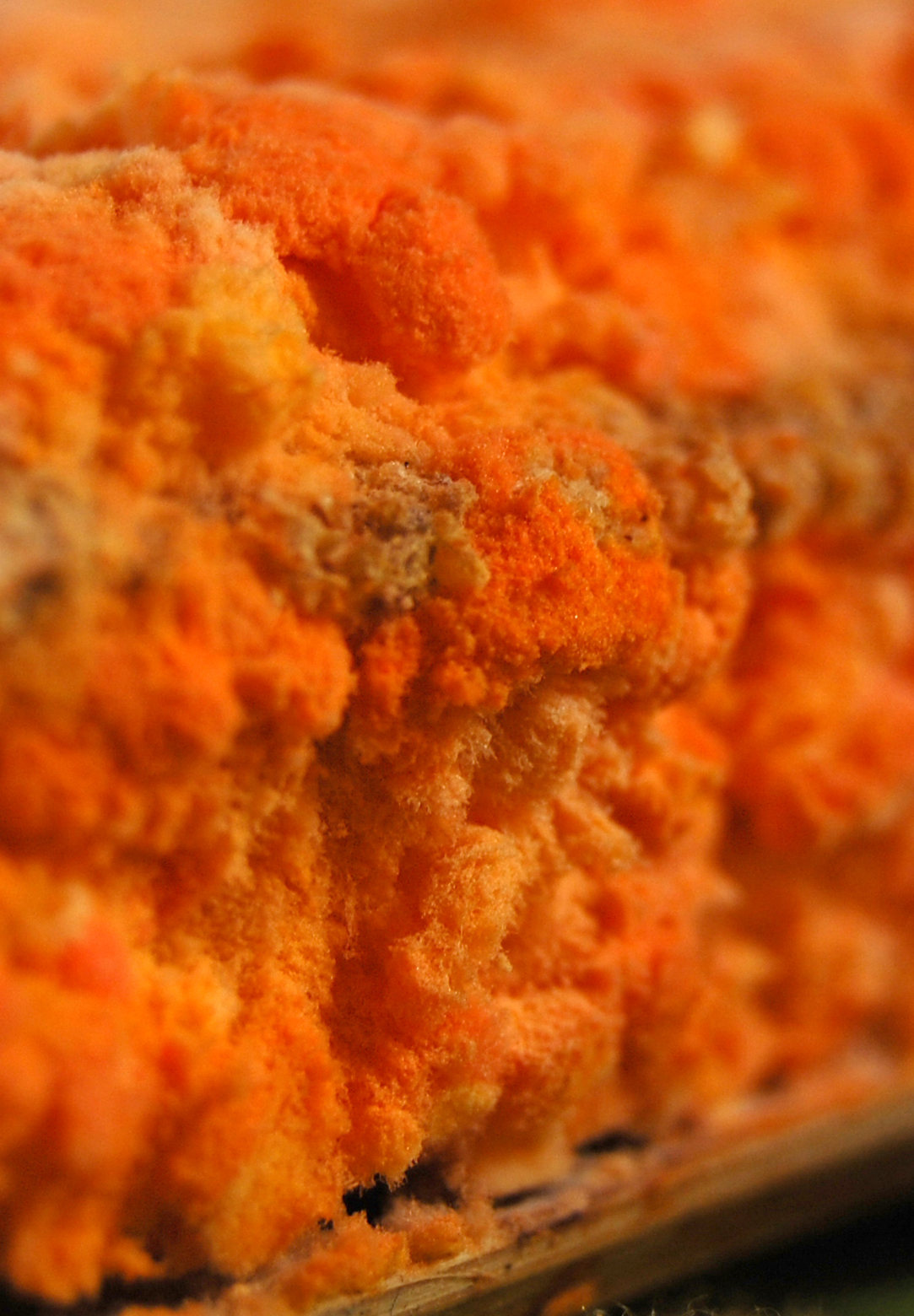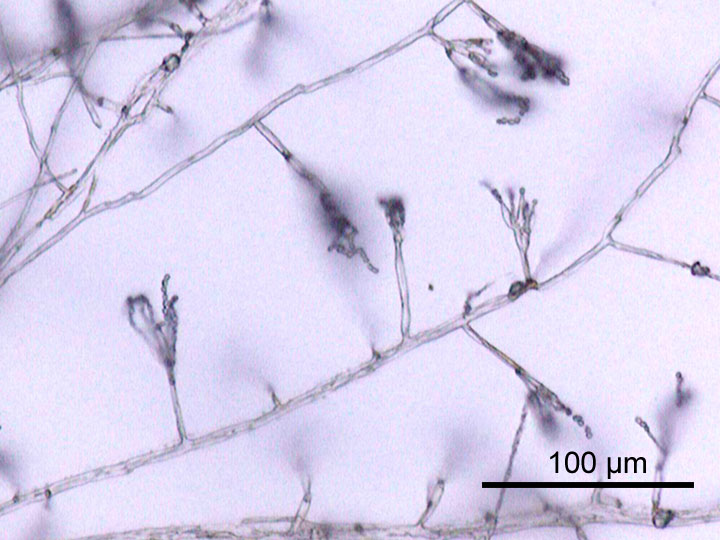|
Heterokaryon
In biology, a heterokaryon is a multinucleate cell that contains genetically different nuclei. This is a special type of syncytium. This can occur naturally, such as in the mycelium of fungi during sexual reproduction, or artificially as formed by the experimental fusion of two genetically different cells, as e.g., in hybridoma technology. Etymology The term ''heterokaryosis'' for the property of having genetically unlike nuclei is borrowed from the German ''Heterokaryosis'', which was coined by the German botanist Hans Burgeff in a 1912 paper about his work on the fungus '' Phycomyces nitens''. It is based on Greek ''hetero'', meaning "different," and ''karyon'', meaning "kernel" or in this case "nucleus.". Occurrence Heterokaryons are found in the life cycle of yeasts, for example ''Saccharomyces cerevisiae'', a genetic model organism. The heterokaryon stage is produced from the fusion of two haploid cells. This ''transient'' heterokaryon can produce further haploid buds, or c ... [...More Info...] [...Related Items...] OR: [Wikipedia] [Google] [Baidu] |
Dikaryon
The dikaryon (karyogamy) is a cell nucleus feature that is unique to certain fungi. (The green alga '' Derbesia'' had been long considered an exception, until the heterokaryotic hypothesis was challenged by later studies.) Compatible cell-types can fuse cytoplasms ( plasmogamy). When this occurs, the two nuclei of two cells pair off and cohabit without fusing ( karyogamy). This can be maintained for all the cells of the hyphae by synchronously dividing so that pairs are passed to newer cells. In the Ascomycota this attribute is most often found in the ascogenous hyphae and ascocarp while the bulk of the mycelium remains monokaryotic. In the Basidiomycota this is the dominant phase, with most Basidiomycota monokaryons weakly growing and short-lived. The formation of a dikaryon is a plesiomorphic character for the subkingdom Dikarya, which consists of the Basidiomycota and the Ascomycota. The formation of croziers in the Ascomycota and of clamp connections in the Basidiomyc ... [...More Info...] [...Related Items...] OR: [Wikipedia] [Google] [Baidu] |
Syncytium
A syncytium (; : syncytia; from Greek: σύν ''syn'' "together" and κύτος ''kytos'' "box, i.e. cell") or symplasm is a multinucleate cell that can result from multiple cell fusions of uninuclear cells (i.e., cells with a single nucleus), in contrast to a coenocyte, which can result from multiple nuclear divisions without accompanying cytokinesis. The muscle cell that makes up animal skeletal muscle is a classic example of a syncytium cell. The term may also refer to cells interconnected by specialized membranes with gap junctions, as seen in the heart muscle cells and certain smooth muscle cells, which are synchronized electrically in an action potential. The field of embryogenesis uses the word ''syncytium'' to refer to the coenocytic blastoderm embryos of invertebrates, such as ''Drosophila melanogaster''. Physiological examples Protists In protists, syncytia can be found in some rhizarians (e.g., chlorarachniophytes, plasmodiophorids, haplosporidians) and acellul ... [...More Info...] [...Related Items...] OR: [Wikipedia] [Google] [Baidu] |
Micronucleus
A micronucleus is a small nucleus that forms whenever a chromosome or a fragment of a chromosome is not incorporated into one of the daughter nuclei during cell division. It usually is a sign of genotoxic events and chromosomal instability. Micronuclei are commonly seen in cancerous cells and may indicate genomic damage events that can increase the risk of developmental or degenerative diseases. Micronuclei form during anaphase from lagging acentric chromosomes or chromatid fragments caused by incorrectly repaired or unrepaired DNA breaks or by nondisjunction of chromosomes. This improper segregation of chromosomes may result from hypomethylation of repeat sequences present in pericentromeric DNA, irregularities in kinetochore proteins or their assembly, a dysfunctional spindle apparatus, or flawed anaphase checkpoint genes. Micronuclei can contribute to genome instability by promoting a catastrophic mutational event called chromothripsis. Many micronucleus assays have been dev ... [...More Info...] [...Related Items...] OR: [Wikipedia] [Google] [Baidu] |
Hunter Syndrome
Hunter syndrome, or mucopolysaccharidosis type II (MPS II), is a rare genetic disorder, inherited lysosomal storage disease in which large sugar molecules called glycosaminoglycans (or GAGs or mucopolysaccharides) build up in body tissues. Hunter syndrome is caused by a deficiency of the lysosome, lysosomal enzyme iduronate-2-sulfatase (I2S). The lack of this enzyme causes heparan sulfate and dermatan sulfate to accumulate in all body tissues. Hunter syndrome is the only MPS syndrome to exhibit X-linked recessive inheritance. The symptoms of Hunter syndrome are comparable to those of Mucopolysaccharidosis type I, MPS I. It causes abnormalities in many organs, including the skeleton, heart, and respiratory system. In severe cases, this leads to death during the teenage years. Unlike MPS I, Corneal dystrophy, corneal clouding is not associated with this disease. Signs and symptoms Hunter syndrome may present with a wide variety of phenotypes. It has traditionally been categorized ... [...More Info...] [...Related Items...] OR: [Wikipedia] [Google] [Baidu] |
Hurler Syndrome
Hurler syndrome, also known as mucopolysaccharidosis Type IH (MPS-IH), Hurler's disease, and formerly gargoylism, is a genetic disorder that results in the buildup of large sugar molecules called glycosaminoglycans (GAGs) in lysosomes. The inability to break down these molecules results in a wide variety of symptoms caused by damage to several different organ systems, including but not limited to the nervous system, skeletal system, eyes, and heart. The underlying mechanism is a deficiency of alpha-L iduronidase, an enzyme responsible for breaking down GAGs. Without this enzyme, a buildup of dermatan sulfate and heparan sulfate occurs in the body. Symptoms appear during childhood, and early death usually occurs. Other, less severe forms of MPS Type I include Hurler–Scheie syndrome (MPS-IHS) and Scheie syndrome (MPS-IS). Hurler syndrome is classified as a lysosomal storage disease. It is clinically related to Hunter syndrome (MPS II); however, Hunter syndrome is X-linked, whi ... [...More Info...] [...Related Items...] OR: [Wikipedia] [Google] [Baidu] |
Amoeboid
An amoeba (; less commonly spelled ameba or amœba; : amoebas (less commonly, amebas) or amoebae (amebae) ), often called an amoeboid, is a type of cell or unicellular organism with the ability to alter its shape, primarily by extending and retracting pseudopods. Amoebae do not form a single taxonomic group; instead, they are found in every major lineage of eukaryotic organisms. Amoeboid cells occur not only among the protozoa, but also in fungi, algae, and animals. Microbiologists often use the terms "amoeboid" and "amoeba" interchangeably for any organism that exhibits amoeboid movement. In older classification systems, most amoebae were placed in the class or subphylum Sarcodina, a grouping of single-celled organisms that possess pseudopods or move by protoplasmic flow. However, molecular phylogenetic studies have shown that Sarcodina is not a monophyletic group whose members share common descent. Consequently, amoeboid organisms are no longer classified together in ... [...More Info...] [...Related Items...] OR: [Wikipedia] [Google] [Baidu] |
Slime Mold
Slime mold or slime mould is an informal name given to a polyphyletic assemblage of unrelated eukaryotic organisms in the Stramenopiles, Rhizaria, Discoba, Amoebozoa and Holomycota clades. Most are near-microscopic; those in the Myxogastria form larger plasmodial slime molds visible to the naked eye. The slime mold life cycle includes a free-living single-celled stage and the formation of spores. Spores are often produced in macroscopic multicellular or multinucleate fruiting bodies that may be formed through aggregation or fusion; aggregation is driven by chemical signals called acrasins. Slime molds contribute to the decomposition of dead vegetation; some are parasitic. Most slime molds are terrestrial and free-living, typically in damp shady habitats such as in or on the surface of rotting wood. Some myxogastrians and protostelians are aquatic or semi-aquatic. The phytomyxea are parasitic, living inside their plant hosts. Geographically, slime molds are cosmopo ... [...More Info...] [...Related Items...] OR: [Wikipedia] [Google] [Baidu] |
Neurospora
''Neurospora'' is a genus of Ascomycete fungi. The genus name, meaning "nerve spore" refers to the characteristic striations on the spores that resemble axons. The best known species in this genus is '' Neurospora crassa'', a common model organism in biology. '' Neurospora intermedia'' var. ''oncomensis'' is believed to be the only mold belonging to ''Neurospora'' which is used in food production (to make oncom). Characteristics ''Neurospora'' species are molds with broadly spreading colonies, with abundant production of ascomata. Ascomata are superficial or immersed, perithecial and ostiolate or cleistothecial and non-ostiolate, hairy or glabrous, dark coloured. Peridium membranaceous, asci cylindrical, clavate or subspherical, with a persistent or evanescent wall, usually with a thickened and non-amyloid annular structure at the apex, usually 8-spored. Ascospores broadly fusiform, ellipsoidal, or nearly spherical, unicellular, hyaline to yellowish brown or olive-brown, be ... [...More Info...] [...Related Items...] OR: [Wikipedia] [Google] [Baidu] |
Basidiomycota
Basidiomycota () is one of two large divisions that, together with the Ascomycota, constitute the subkingdom Dikarya (often referred to as the "higher fungi") within the kingdom Fungi. Members are known as basidiomycetes. More specifically, Basidiomycota includes these groups: agarics, puffballs, stinkhorns, bracket fungi, other polypores, jelly fungi, boletes, chanterelles, earth stars, smuts, bunts, rusts, mirror yeasts, and '' Cryptococcus'', the human pathogenic yeast. Basidiomycota are filamentous fungi composed of hyphae (except for basidiomycota-yeast) and reproduce sexually via the formation of specialized club-shaped end cells called basidia that normally bear external meiospores (usually four). These specialized spores are called basidiospores. However, some Basidiomycota are obligate asexual reproducers. Basidiomycota that reproduce asexually (discussed below) can typically be recognized as members of this division by gross similarity to others, by ... [...More Info...] [...Related Items...] OR: [Wikipedia] [Google] [Baidu] |
Ascomycota
Ascomycota is a phylum of the kingdom Fungi that, together with the Basidiomycota, forms the subkingdom Dikarya. Its members are commonly known as the sac fungi or ascomycetes. It is the largest phylum of Fungi, with over 64,000 species. The defining feature of this fungal group is the "ascus" (), a microscopic sexual reproduction, sexual structure in which nonmotile spores, called ascospores, are formed. However, some species of Ascomycota are Asexual reproduction, asexual and thus do not form asci or ascospores. Familiar examples of sac fungi include morels, truffles, yeast#Beer, brewers' and bakers' yeast, Xylaria, dead man's fingers, and cup fungi. The fungal symbionts in the majority of lichens (loosely termed "ascolichens") such as ''Cladonia'' belong to the Ascomycota. Ascomycota is a monophyletic group (containing all of the descendants of a common ancestor). Previously placed in the Basidiomycota along with asexual species from other fungal taxa, asexual (or Teleomorph, ... [...More Info...] [...Related Items...] OR: [Wikipedia] [Google] [Baidu] |
Hyphae
A hypha (; ) is a long, branching, filamentous structure of a fungus, oomycete, or actinobacterium. In most fungi, hyphae are the main mode of vegetative growth, and are collectively called a mycelium. Structure A hypha consists of one or more cells surrounded by a tubular cell wall. In most fungi, hyphae are divided into cells by internal cross-walls called "septa" (singular septum). Septa are usually perforated by pores large enough for ribosomes, mitochondria, and sometimes nuclei to flow between cells. The major structural polymer in fungal cell walls is typically chitin, in contrast to plants and oomycetes that have cellulosic cell walls. Some fungi have aseptate hyphae, meaning their hyphae are not partitioned by septa. Hyphae have an average diameter of 4–6 μm. Growth Hyphae grow at their tips. During tip growth, cell walls are extended by the external assembly and polymerization of cell wall components, and the internal production of new cell membran ... [...More Info...] [...Related Items...] OR: [Wikipedia] [Google] [Baidu] |
Mutation
In biology, a mutation is an alteration in the nucleic acid sequence of the genome of an organism, virus, or extrachromosomal DNA. Viral genomes contain either DNA or RNA. Mutations result from errors during DNA or viral replication, mitosis, or meiosis or other types of damage to DNA (such as pyrimidine dimers caused by exposure to ultraviolet radiation), which then may undergo error-prone repair (especially microhomology-mediated end joining), cause an error during other forms of repair, or cause an error during replication ( translesion synthesis). Mutations may also result from substitution, insertion or deletion of segments of DNA due to mobile genetic elements. Mutations may or may not produce detectable changes in the observable characteristics ( phenotype) of an organism. Mutations play a part in both normal and abnormal biological processes including: evolution, cancer, and the development of the immune system, including junctional diversity. Mutati ... [...More Info...] [...Related Items...] OR: [Wikipedia] [Google] [Baidu] |




